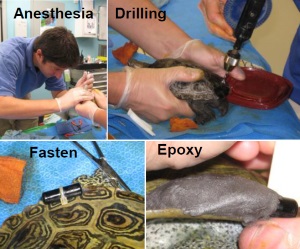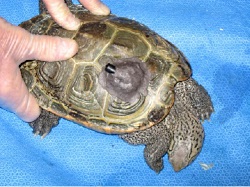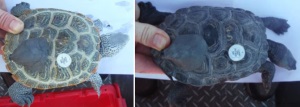Research - Transmitter Retention Studies
Two critical considerations for conducting telemetry studies are (a) assurance that transmitters will remain attached to study subjects and that (b) attachment of devices does not alter behavior. Therefore, in order to ensure that reliable telemetry data could be collected for terrapins, especially small males, a collaborative transmitter-retention study was conducted in partnership with the South Carolina Aquarium (SCA) on 10 October 2012. A total of nine terrapins were included in this study, including one male and one female that served as behavioral "controls" and did not receive a transmitter (measurement = 9 mm diameter x 29 mm length; weight = 4.7 g in air, 2.9 g in water); for this study, 'dummy' transmitters devoid of electronics were used. Two different transmitter attachment techniques were evaluated.

The first attachment technique was previously used with adult female terrapins12 and known to have the potential to provide a year-long transmitter attachment, the duration of transmitter battery life. Because of the invasive nature of this technique, terrapins received a general anesthetic and pain medication (administered by Dr. Shane Boylan, D.V.M.) prior to drilling a small (1.6mm) hole through a marginal scute near the right rear of the terrapin. The drill bit was also cleansed in a 10% betadine solution in between terrapins and alcohol was applied to the scute before drilling. Once the hole was drilled, the transmitter was secured using a plastic zip tie and after the excess tie was snipped, a two-part epoxy putty (SonicWeld®) was used to cover all but the terminal transducer end of the transmitter. Transmitters were attached to three male and two female terrapins using the drill-and-secure method.

The second attachment technique relied exclusively on SonicWeld to secure the transmitter to the terrapin. Prior to attachment, barnacles and encrusting bryozoans were gently scraped from the vertebral and costal scutes while fine-scale organic matter such as algae was scrubbed off using alcohol-soaked gauze pads. Loose keratin scutes were carefully peeled away and 100-grit sandpaper was lightly applied to ensure no loose keratin remained. A base layer of epoxy was then pressed onto the carapace across at least three scute seams to minimize the risk of transmitter loss due to detachment of a single scute. The epoxy was molded into a shape that had a centralized dome. Next, the transmitter was pressed onto the epoxy dome with the transducer end of the transmitter facing towards the rear of the animal. Epoxy was then applied over top of the transmitter and blended evenly; this technique was affectionately referred to as "pig in a blanket" given resemblance to a hotdog wrapped up inside a biscuit.

All nine terrapins were released back into the Saltmarsh Exhibit at the SCA the next day and monitored by staff and visitors alike. Direct, qualitative observations indicated no difference in behavior between untagged and tagged terrapins upon return to this familiar habitat. Four drill-and-secure transmitters were shed or otherwise detached 176 to 807 days later, and the fifth transmitter was lost after 84 days when a male died from causes unrelated to tagging. The first epoxy-only transmitter was shed after 394 days and the second was lost after approximately two years. Based on initial results, we opted to use the epoxy-only technique in the field study, but restricted transmitter attachment to males ≤300 g consistent with a similar study in Virginia21, despite the smallest male in the SCA transmitter retention study weighing 340g.

On 8 September 2015, the terrapin telemetry partnership between the SCDNR and the SCA was renewed when two small (300 to 350g) terrapins reared from hatchlings at the SCA were tagged with acoustic transmitters prior to release in the headwaters of Orange Grove Creek.
These two terrapins exhibited different behaviors upon release into unfamiliar habitats. One terrapin (338 detections) remained in the headwaters of Orange Grove Creek for two days before entering the Ashley River and heading down river to Charleston Harbor; this terrapin traveled as far as the mouth of Charleston Harbor before changing course and traveling up into the Cooper River and later the Wando River where it was last detected near Drum Island on 7 October 2015. The second terrapin (121 detections) ceased to be detected in Orange Grove Creek within an hour of release; however, a week later and through 1 October this terrapin was routinely detected in the Ashley River between Bull Creek and Charleston Harbor. Both sets of movements were within the range of distances traveled by some wild terrapins tagged by SCDNR researchers.
